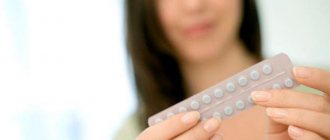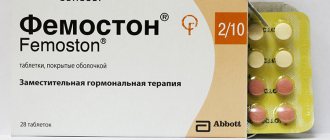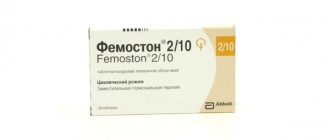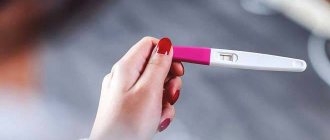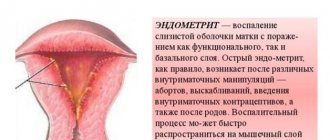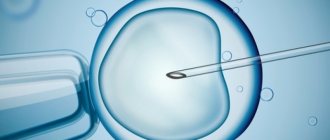The situation when a woman’s body disrupts the production of its own sex hormones is quite common.
These are, first of all, conditions associated with the onset of menopause or surgical removal of the reproductive organs (ovaries, uterus). In this situation, the main goal of therapy is to compensate for the deficiency of the hormone estrogen and eliminate the consequences of its lack for the body. The drug Femoston is included in the list of drugs to combat the manifestations of the above conditions.
Composition and dosage
Femoston in its structure is a combined drug containing estradiol (estrogen component) and dydrogesterone (gestagen component). Depending on the concentration of each component, the pharmaceutical industry produces the following dosages:
- Femoston conti 1/5 (contains 1 mg estradiol and 5 mg dydrogesterone);
- Femoston 1/10 (1 mg estradiol and 10 mg dydrogesterone);
- Femoston 2/10 (2 mg estradiol and 10 mg dydrogesterone).
Femoston conti differs from others not only in the lower dosage of the progestin component, but also in the constancy of the chemical composition in each tablet (monophasic).
In turn, Femoston 1/10 and 2/10 are two-phase drugs. This is manifested in the changing composition of the tablets depending on the phase of the cycle. The first 14 tablets contain only estrogen, the next 14 include estrogen and progestogen.
There are various release forms and the number of tablets per package: 28, 84 or 280.
What is Femoston?
Is it possible to get pregnant while taking Femoston? It’s worth saying right away that this drug does not belong to the OK category, so reproductive function is preserved.
Femoston is a hormonal drug that contains the synthetic hormone 17β-estradiol and dydrogesterone. These components are synthetic analogs of female hormones - estradiol and progesterone, respectively. Thanks to this composition, not only protection against unwanted pregnancy is ensured, but also the full growth of the endometrium and the onset of menstruation, which is very important for the normal functioning of the reproductive system.
The drug is used:
- as hormone replacement therapy for disorders caused by physiological or surgical menopause;
- for preventive purposes, preventing osteoporosis in postmenopausal women with a high risk of fractures in cases where there is individual intolerance to the components of other drugs that are intended to prevent such diseases.
As for how to take the remedy. It’s worth saying right away that the dosage is selected individually and depends on the patient’s diagnosis. For example, one of the common regimens for taking Femoston 2/10 is 1 tablet once a day.
Advice! Taking Femoston does not depend on food intake, but doctors strongly recommend taking the tablets at the same time. In the first 2 weeks of the cycle, pink pills are taken, and starting from the 15th day - light yellow.
Modern doctors will not prescribe hormonal drugs just like that or just in case, because everything requires indications. True, there are not many such specialists today. The rest prescribe this or that drug, following commercial benefits. If the specialist is highly competent, before prescribing this or that therapy to the patient, he prescribes a series of clinical studies. An ultrasound examination also takes place.
In this case, the ultrasound procedure helps determine the functionality of the endometrium. In addition, there are a number of procedures that help determine the possibility of natural conception. But this is all purely individual.
On some forums you can find information that additional use of Duphaston is recommended in the 2nd phase of the menstrual cycle. But this is all purely individual, so it is not advisable to make such decisions on your own without consulting a specialist.
Mini-instructions for use of the drug
The main property of Femoston is the regulation of the level of its own sex hormones. Each of the components of the composition performs its role sequentially in a certain phase of the cycle.
In the follicular phase, estradiol promotes the active growth of the uterine mucosa and, thus, reproduces the physiological model of the menstrual cycle. On day 15, the pill you take already includes dydrogesterone, which regulates estrogen activity. This is necessary to prevent excessive growth of the endometrium, as well as to reduce the risks of malignant degeneration of the uterine epithelium under the influence of estradiol.
Thanks to the rapid normalization of hormonal levels, regular use of Femoston helps to cope with the following undesirable manifestations of menopause:
- hot flashes;
- sweating and chills;
- worsening mood, depression;
- dry skin and mucous membranes, vaginal itching;
- brittle bones, osteoporosis, etc.
Due to the specificity of the effects on the body, the main indications for taking the drug are:
- menopause (natural or artificial);
- prevention of bone tissue destruction if other drugs are not effective or cannot be used.
Another undoubtedly positive effect of the drug on the body is the normalization of cholesterol levels in the blood, increasing the concentration of high-density lipoproteins and reducing low-density lipoproteins. This feature is taken into account by cardiologists when identifying problems with the lipoprotein composition of the blood in a woman at menopausal age.
Femoston® 1 (Femoston® 1)
The drug is prescribed only in the presence of symptoms that adversely affect the quality of life. All patients receiving HRT at least once a year require a benefit/risk assessment. Therapy should be continued until the benefits of taking the drug outweigh the risk of adverse reactions. Experience with the drug in women over 65 years of age is limited.
Information about the risks associated with 3HT in cases of premature menopause is limited. Due to the lower absolute risk in younger women, their benefit/risk ratio may be more favorable than in older women.
Medical examination
Before starting or resuming taking Femoston® 1, it is necessary to collect a complete medical and family history and conduct a general and gynecological examination (including the mammary glands) of the patient in order to identify possible contraindications and conditions requiring precautions. While taking Femoston® 1, it is recommended to conduct periodic examinations, the frequency and nature of which are determined individually, but not less than once every 6 months. It is advisable to perform mammography for additional examination of the mammary glands. Women should be informed about those possible changes in the mammary glands that need to be reported to their doctor.
If there is a family history of thrombosis or thromboembolism in first-degree relatives under the age of 50 years while taking the drug for HRT, careful medical supervision is necessary.
The use of estrogens may affect the results of the following laboratory tests: determination of glucose tolerance, study of thyroid and liver functions.
Reasons for immediate discontinuation of therapy:
Therapy should be discontinued if contraindications are established, as well as in the following cases:
-Jaundice or deterioration of liver function
- Significant increase in blood pressure
-Onset of migraine-type headaches
-Pregnancy
Hyperplasia and endometrial cancer
The risk of developing endometrial hyperplasia and cancer when using HRT drugs containing only estrogen depends on the dose and duration of treatment and increases from 2 to 12 times compared to patients not receiving therapy; the risk may remain elevated for 10 years after stopping therapy.
In women with a preserved uterus, the use of HRT drugs containing only estrogen is not recommended due to the increased risk of developing endometrial cancer. Cyclic use of progestogen (at least 12 days of a 28-day cycle), or use of a continuous combined HRT regimen in women with a preserved uterus, prevents the increased risk of endometrial hyperplasia and cancer associated with estrogen use.
For the purpose of timely diagnosis, it is advisable to conduct ultrasound (US) screening and, if necessary, conduct a histological (cytological) examination.
Bloody vaginal discharge
In the first months of taking the drug, there may be bleeding and/or scanty spotting from the vagina. If such bleeding appears some time after the start of therapy or continues after cessation of treatment, its cause should be determined. An endometrial biopsy may be performed to rule out malignancy.
Venous thromboembolism
HRT is associated with a 1.3-3-fold risk of developing venous thromboembolism (VTE), i.e. deep vein thrombosis or pulmonary embolism. The development of this phenomenon is most likely during the first year of HRT.
If there are thromboembolic complications in first-degree relatives at a young age, as well as with a history of recurrent miscarriage, it is necessary to conduct a hemostasis study (during screening, only some disorders of the blood coagulation system are detected). If the patient is taking anticoagulants, it is necessary to carefully consider the prescription of Femoston® 1 from the point of view of the benefit/risk ratio. Until a thorough assessment of the factors for the possible development of thromboembolism or the initiation of anticoagulant therapy is completed, Femoston 1 is not prescribed.
If a hereditary or acquired predisposition to arterial or venous thrombosis is identified (for example, hyperhomocysteinemia, protein C deficiency, protein S deficiency, antithrombin III deficiency, etc., as well as their combination) and/or the presence of such conditions in the family history (in relatives 1st degree of relationship) taking Femoston® 1 is contraindicated due to the increased risk of thrombosis and thromboembolism, including venous.
In most cases, risk factors for developing VTE include: estrogen use, older age, major surgery, prolonged immobilization, obesity (body mass index > 30 kg/m2), pregnancy or the postpartum period, systemic lupus erythematosus and cancer. There is no consensus on the possible role of varicose veins in the development of VTE.
To prevent VTE after surgery, prophylactic measures should be considered in all postoperative patients.
In case of prolonged immobilization after surgery, you should stop taking Femoston® 1 4-6 weeks before and not resume taking the drug until the woman’s motor activity is completely restored.
If VTE develops after initiation of therapy, the drug should be discontinued and patients should be informed that they should contact their physician immediately if any of the symptoms indicating possible thrombosis or thromboembolism occur (for example, pain or swelling of the lower extremities, sudden chest pain, shortness of breath).
Mammary cancer
In women who have been receiving HRT for a long time containing only estrogen or combined (estrogen + progestogen) drugs, the incidence of breast cancer diagnosis increases, which returns to the original level within 5 years after cessation of therapy.
The increase in risk depends on the duration of HRT use. In women taking combined HRT drugs for more than 5 years, the risk of developing breast cancer can increase up to 2 times.
Combination therapy with estrogen and progestogen
The results of a randomized placebo-controlled trial (Women's Health Initiative (WHI)) and epidemiological studies showed an increased risk of developing breast cancer in women taking combined drugs for HRT (estrogen + progestogen). This increase becomes noticeable after approximately three years of therapy.
While taking HRT medications, there may be an increase in the density of breast tissue during mammography, which can make it difficult to diagnose breast cancer.
Ovarian cancer
Ovarian cancer is much less common than breast cancer. Epidemiological data from a large meta-analysis suggest a small increase in the risk of ovarian cancer for women receiving combined or estrogen-only HRT.
These studies (increased risk) become more apparent when therapy lasts more than five years, and after discontinuation, the risk gradually decreases over time. Findings from a number of other studies, including the WHI, indicate that combined HRT is associated with a similar or slightly lower risk of ovarian cancer.
Risk of ischemic stroke
Combination therapy with estrogen and progestogen or therapy with estrogen alone is associated with a 1.5-fold increase in the relative risk of ischemic stroke. The risk of hemorrhagic stroke does not increase when receiving HRT.
The relative risk does not depend on age, time of menopause, or duration of therapy. However, the baseline risk is highly dependent on age, so the overall risk of stroke in women taking HRT will increase with age.
Coronary heart disease (CHD)
Randomized controlled clinical trials provided no evidence of a protective effect of HRT against myocardial infarction in women with or without CAD who received combined estrogen and progestogen HRT or estrogen alone.
Combination therapy with estrogen and progestogen
The relative risk of coronary heart disease during the use of combined estrogen and progestogen HRT is slightly increased. Because the absolute risk of CAD is highly dependent on age, the number of additional cases of CAD due to combined HRT use in healthy premenopausal women is very small, but increases with age. The risk is slightly higher in women over 60 years of age.
Other states
Estrogens can cause fluid retention, which may adversely affect patients with impaired renal or cardiac function. This group of patients should be under medical supervision. Patients with hypertriglyceridemia while taking HRT medications should also be under medical supervision, because There are reports of very rare cases of significant increases in the concentration of triglycerides in the blood plasma, which contributes to the development of pancreatitis.
Estrogens increase the concentration of thyroxine-binding globulin, which leads to an overall increase in the concentration of circulating thyroid hormones (measured by determination of iodine bound to plasma proteins), the concentration of thyroxine (T4) - chromatographic or radioimmunoassay, or triiodothyronine (T3) - radioimmunoassay. The labeled triiodothyronine uptake test shows an increased concentration of thyroxine-binding globulin. The concentrations of free hormones T3 and T4 usually do not change. Plasma concentrations of other binding proteins (eg, transcortin and sex hormone binding globulin) may also increase, resulting in increased concentrations of circulating corticosteroids and sex hormones.
The concentrations of free or biologically active hormones do not change. It is possible to increase the concentration of other plasma proteins (angiotensinogen/renin system, α-1-antitrypsin, ceruloplasmin).
The use of HRT does not improve cognitive function. There are reports of an increased risk of developing dementia in women who start using HRT (combined or estrogen-containing only) after 65 years.
Femoston® 1 is not a contraceptive.
Femoston and infertility
In addition to clinically proven indications for use, there is a practice of taking the drug in the treatment of infertility caused by hypofunction of the uterine epithelium. The prescription of Femoston when planning pregnancy is based on its ability to cause active growth of the endometrium in the first phase of the cycle. For a lasting therapeutic effect, it is recommended to continue therapy for 2-3 months. Pregnancy becomes possible after discontinuation of the drug.
This treatment tactic has both its supporters and opponents. Negative reviews from doctors and patients are usually associated with a high risk of side effects and the presence of a number of contraindications. However, the effect of the therapy is controversial.
Form and composition of the drug, properties of the components
Femoston is produced in the form of tablets enclosed in a film coating of different colors:
- The pink pills contain only one active compound – estrodiol. Its amount is 2 mg.
- The yellowish tablets, in addition to the same content of estradiol, also contain a second active ingredient - dydrogesterone. Its concentration is 10 mg.
Otherwise, the composition of the tablets is the same, differing only in the set of film coating ingredients.
Component properties:
- Estradiol is an artificially synthesized substitute for the female hormone estrogen. Replenishes the lack of endogenous substances and protects bone tissue from destruction. After oral administration, it is absorbed fairly quickly, transformed in the liver and excreted from the body in the urine. Due to its high activity, it passes into mother's milk, so it is not prescribed to lactating women.
- Dydrogesterone is also a synthetic compound that has the properties of human progesterone. Included in Femoston 2/10 when planning pregnancy due to its ability to correct the condition of the endometrium and promote its growth, during which the zygote attaches. The substance is quickly absorbed and converted in the liver. Its derivatives are excreted from the body in the urine.
Peak concentrations in the blood occur within half an hour after taking Femoston. The half-life takes about 7 hours, and the body is completely freed from the drug on average in three days.
Why is an anti-menopause remedy used to prepare for pregnancy?
Prescribing an antimenopausal drug to women who want to become a mother may seem strange. What makes it even more intriguing is the instruction in the instructions that pregnant women should not drink it. What is the correlation between the fact that a product is recommended to be taken in preparation for conception and pregnancy, and at the same time is prohibited for expectant mothers? This state of affairs may seem strange only at first glance. Therefore, it is worth taking a closer look at how Femoston 2/10 and pregnancy are related to each other.
In fact, there is no contradiction: although the remedy is initially aimed at alleviating the condition of menopause, which occurs for natural reasons or as a result of surgery, it also has a beneficial effect on the endometrium in women of reproductive age. The medicine stimulates the normal functioning of the tissue, which has a positive effect on a woman’s ability to become pregnant.
After gynecologists drew attention to these properties of the drug, they began to prescribe it to women with infertility problems. After all, if the level of estrogen in the body is low, then this negatively affects the condition of the endometrium: it does not develop properly, and its thickness is not enough for the normal attachment of a fertilized egg. But even if implantation occurs, the endometrium that is too thin will not be able to provide all the substances necessary for development, and over time the zygote will be rejected.
The use of a hormonal remedy eliminates all these problems. For this reason, gynecologists actively prescribe Femoston to women with problems conceiving or bearing fruit.
Contraindications and side effects
The initiation of treatment with Femoston must be accompanied by a preliminary comprehensive medical examination of the woman. Data is collected on the presence of a number of diseases in the anamnesis, as well as other conditions for which taking the drug is contraindicated.
The main contraindications include:
- hormone-dependent neoplasms of the reproductive organs or mammary glands;
- vaginal bleeding, the cause of which is not clear;
- arterial hypertension;
- pregnancy and breastfeeding;
- thrombosis;
- kidney and liver diseases;
- endometriosis, etc.
Often refusal of Femoston therapy is the occurrence of the following side effects:
- swelling;
- disruption of the gastrointestinal tract;
- headache;
- pain in the mammary glands and pelvic organs;
- weight change.
Which is better: Femoston, Klimonorm or Angelique?
Drugs of similar composition for the correction of menopausal symptoms include Klimonorm and Angeliq.
Just like Femoston, these are combined (estrogen and gestagen) agents. The main difference between the drug Angelique is its monophasic nature and the presence of a progestin component in the form of drospirenone. The main indications for use of the drug are menopause and the prevention of osteoporosis associated with a lack of intrinsic estrogen.
The drug is available in the form of tablets 28 and 84 pcs. with constant dosage:
- estradiol 1 mg;
- drospirenone 2 mg.
Klimonorm differs from previous drugs in the dosage of the active ingredients. The package contains:
- 9 estradiol tablets with a dosage of 2 mg;
- 12 combination pills (estradiol 2 mg, levonorgestrel 150 mcg).
Thus, one cycle involves taking 21 tablets once a day and 7 days off. Thanks to this feature, the drug is used not only in eliminating the symptoms of menopause, but also for correcting the menstrual cycle in women of reproductive age.
Consider whether it is worth taking it: side effects from using Duphaston.
Reviews of doctors and patients about Femoston tablets can be read at our link.
How to determine if you have hepatitis C: https://venerolog-ginekolog.ru/venereology/zppp/lechenie-gepatita-c.html
Femoston when planning pregnancy
Many women who are taking this drug or planning to take it are worried about what happens to the eggs, because it is, after all, a hormonal drug. Some even think that ovulation will not occur. So what happens to the eggs while taking Femoston?
The instructions for the drug clearly indicate that Femoston is not an oral contraceptive. There are 2 mechanisms of “work” of contraceptives:
- suppression of follicle maturation;
- thickening of the cervical secretion, due to which the movement of sperm to the egg is very difficult.
When using OCs that work by suppressing folliculogenesis, the production of follicle-stimulating and luteinizing hormones is inhibited. A decrease in the concentration of FGS leads to a decrease in the level of estradiol, which, in turn, inhibits ovulatory processes.
Considering that the main active ingredient of Femoston 2/10 or any other dosage is estradiol, then while taking this drug, it turns out that the missing hormone is additionally introduced into the body. As a result, it turns out that this remedy is not able to suppress ovulatory processes and the chances of conception, in the absence of pathologies, are preserved.
In turn, contraceptives from the mini-pill series contribute to the thickening of cervical secretions. This effect of OK does not prevent the maturation and release of the female reproductive cell; it simply inhibits the movement of sperm through the uterine cavity and tubes.
Based on the above, Femoston does not work on the principle of contraceptive drugs - there is no blocking of ovulatory processes. Therefore, in the absence of any pathological conditions in the reproductive system, the likelihood of pregnancy remains.
If pregnancy occurs while taking the drug, the drug will be able to maintain the required level of hormones in the body of the expectant mother.
Are there any other analogs of Femoston?
Often, women during menopause, in addition to hormone-containing drugs, are also prescribed drugs of a different chemical nature. Main groups:
- homeopathic phytoestrogens (Remens, Klimadinon, Estrovel);
- antidepressants (Venlafaxine, Fluoxetine);
- antiepileptic drugs (Gabapentin).
For health reasons, other means of symptomatic therapy may be prescribed.
Hormonal antimenopausal drugs have a number of desirable and undesirable features associated with the effect of estrogens on the body. Before starting to take this group of drugs, you should always weigh all the advantages and disadvantages of the therapy.
See also a video about the use of Femoston during menopause:
